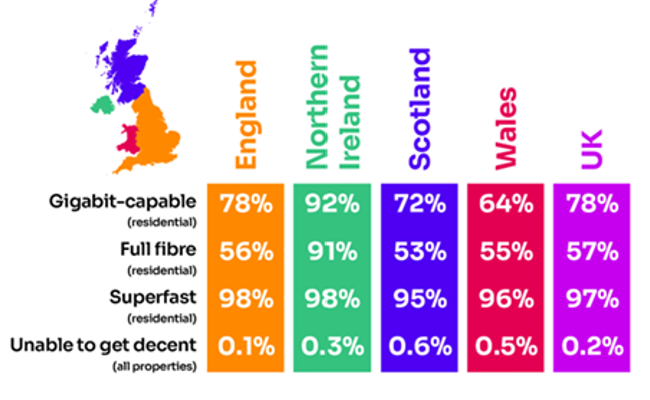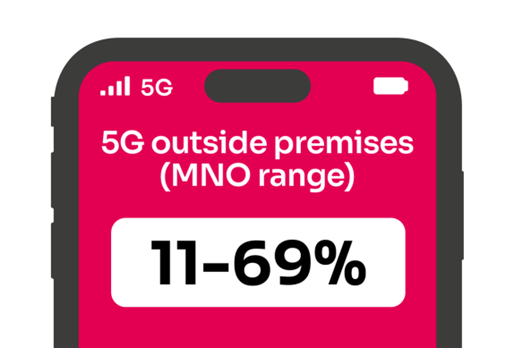
- 55% of homes in Wales now have access to full-fibre, up from 40% last year and in line with the UK average (57%)
- Full-fibre availability varies across the twenty two local authorities in Wales
- 5G mobile coverage continues to grow in Wales
A record 798,000 Welsh homes have access to full-fibre broadband –an increase of 15 percentage points or an additional 227,000 premises compared to last year, according to Ofcom’s latest Connected Nations report published today.
Take up of full-fibre broadband where it is available is 31%, which equates to 239,000 premises – up three percentage points from last year, and higher than UK-wide take up of 28%. For the first time, full-fibre broadband is available to over half of homes in all four of the UK nations. Northern Ireland leads the way, with over nine in 10 homes (91%) able to get full fibre.
Full-fibre broadband uses fibre all the way to your home. It is more reliable and resilient than copper, and our new analysis shows that some providers experience fewer faults [1] on their fibre network compared with a copper-based network. Gigabit capable networks, which include both full fibre and cable, also deliver faster upload and download speeds that make for a better experience when gaming, working and video calling.

Full-fibre broadband availability in Wales is higher in urban areas (59%) than rural (41%), and today’s report also highlights the variation in full-fibre broadband availability across local authorities in Wales. Conwy and Vale of Glamorgan lead the way on full-fibre availability at 79% and 77% respectively, while Torfaen and Ynys Môn have the lowest levels at 22% and 31%.
The rapid rise in availability of full-fibre broadband is good news for people and businesses in Wales, with thousands more able to benefit from fast, reliable and future-proof internet. It is also encouraging to see that where the technology is being available, people are increasingly taking advantage of it, especially in rural parts of Wales.
Eleanor Marks, Ofcom’s Director in Wales
There’s been a further reduction in the number of homes and businesses in Wales unable to access ‘decent’ [2] broadband via a fixed line in the last year, decreasing by 8,000 premises to 36,000 in the last year. Of these premises, some will be able to access decent broadband from fixed wireless access services (FWA), delivered by mobile network operators on 4G and 5G networks, and by wireless internet service providers.
Taking account of the higher availability of coverage from FWA services in Wales compared to the rest of the UK (31% vs 7%), this leaves around 8,000 premises in Wales without a decent broadband service from either fixed line or fixed wireless network. Around 1,000 of these will be connected via publicly funded schemes by next year, showing more progress to come as Wales becomes increasingly connected.
Rollout of 5G mobile gathers pace, as legacy networks begin to close down
The availability of 5G continues to grow in Wales, with coverage available outside premises in Wales by at least one operator at 72% [3], third in the UK behind England and Scotland.

4G continues to underpin the mobile experience in Wales with geographic mobile coverage across the country ranging from 73-85%, depending on the operator. Coverage from all four operators is available across 62% of Wales, unchanged from last year.
Across the UK, mobile network operators are starting to switch off their 3G networks, with EE, Vodafone and Three planning on doing so next year followed by Virgin Media O2 in 2025. Ofcom data shows that there are around 2.4 million devices in the UK still reliant on 2G or 3G networks, which has more than halved from last year’s estimated 5.5 million. Of all network data traffic, just 3% is used by 3G, which has decreased by over two fifths (44%) year on year.
Ofcom continues its work to ensure consumers are treated fairly and that disruption is minimised during the 3G switch-off process. Mobile users who are still dependent on 3G can read Ofcom’s guide.
Notes:
- Over the last three years, for both KCOM and Openreach, the fault rate (per 1,000 connections) on KCOM‘s copper access network (ADSL) and Openreach‘s copper access networks (ADSL / VDSL) was around 50% higher than the fault rates on their respective FTTP networks.
- ‘Decent’ broadband is defined by the Government as delivering at least 10 Mbit/s download and 1 Mbit/s upload speeds.
- Refers to very high confidence of 5G coverage availability for areas outside of premises in Wales where at least one mobile network operator provides coverage.
